March 8, 2010
Facts & figures: The first 20 months of our small SaaS start-up going for premium-only instead of freemium
37signals, poster child of our industry, claims to serve more than 3 million users. What they don’t tell is, how many of those people pay for the premium version of their web apps (Basecamp, Highrise et al). All of them are served in the freemium business model, which is: use a basic version of the product for free, decide later to upgrade to a paid version with extra features, more storage or the like. Evernote, offering a (great) freemium »remember everything« notebook, served more than 500,000 users in summer 2009, according to the New York Times. But, even $79,000 in monthly revenue could not cover their striking expenses for servers and staff which a user base this huge demands. Bottom line: Evernote was in the red.
So what about the smaller, premium-only services? Those, who offer Software as a Service as well, but not in the freemium model? Those, who do not make 5 customers pay to support 95 users? How big can their customer base grow, and at which rate – not having access to hundreds of thousands of users who could rave about the service? Is it possible to grow via referrals only nevertheless? Even if the service doesn’t make it on TechCrunch, RWW et al? Or is VC money the only way then, to pay for advertising crusades? Or is it this whole idea, premium-only, downright stupid? Is freemium the only way, even for a service such us mite, a time tracking tool with a clear benefit focused solely on business customers?
The force driving this article
When thinking about starting our company, we were desperate for in-depth figures of real-life start-ups, who’d been there before. We’d given an arm, a leg and at least one macbook for figures providing insight into the early stage of development, making it possible to understand the evolution of such a business, not only a certain point in time, a result. This would have allowed us to base our vague assumptions on real success – or the lack of it. We craved for such figures. But we didn’t find them.
Well: let’s change that. Let’s publish those facts and figures ourselves. Hopefully, this’ll help somebody out there to take a chance! No matter what: we do believe in sharing experiences and knowledge openly. We therefore chose to contribute. Even if this information is probably the most sensible to divulge.
mite: facts and figures
Trials per month
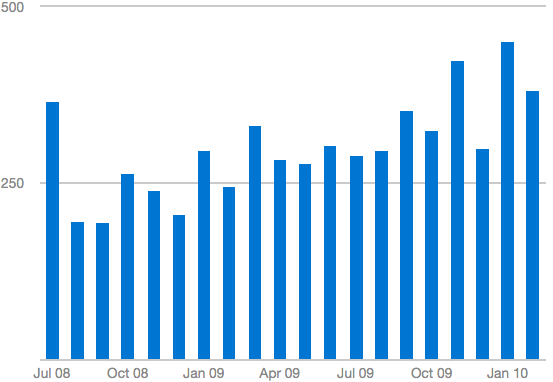
For 30 days, users are welcome to give our time tracking tool a try. Trials are fully-featured, and: you won’t need a credit card to sign-up; We’re convinced that this is the best decision by far – nobody likes to give away his credit card credentials up-front, whithout a clue if the service is really useful, right? Sign-up just takes a minute. We want to encourage people to try mite in action. That’s when our service convinces best.
Conversion: Once a user, now a customer
Convincing users to sign-up for a trial is just the first step. In the end, what counts is how many of those users become paying customers. Unquestionably, the conversion rate was the hardest parameter to pre-estimate. 5% are a great rate in freemium businesses. We thought that we could top that with our »either/or approach«, and aimed high – for 10%. Ambitious? Yes. Doable? We hoped so, as we had a stable and lovingly crafted enterprise product with a clear financial benefit. A product, that cannot be used in a basic, however restricted version if you’re not up to pay for it.
After 20 months, we do know which rate can be done. Take a look:
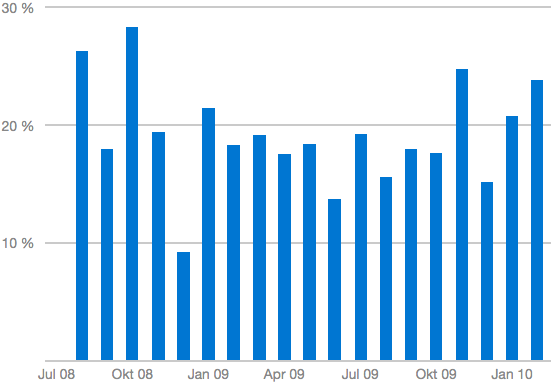
Nearly 20%! Every sixth to fifth trial converts to a paying customer.
That said, we think that the quality of our traffic is the determining factor for this great conversion rate. The biggest part of our visitors reaches our site via a personal referral: a blog post, a tweet, or the recommendation of a co-worker, a freelancer or a customer who is already a customer of ours. (Thank you so much, all of you!) We do not place any ads: no banners, no viral campaigns, no SEM. Instead, we invest solely in improving our product continuously and commit to a great customer service day-by-day.
Paying accounts, paying users
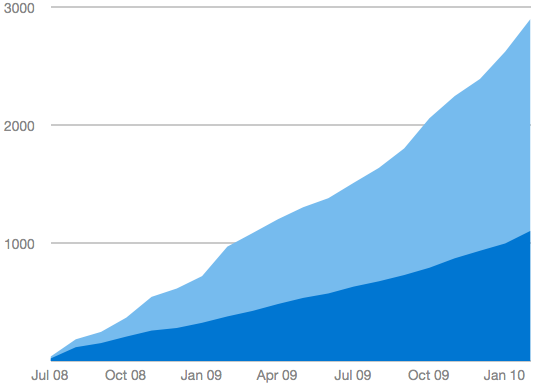
mite is multi-user software. Subscription fees are based on the number of active users per account. Therefore, the figure most important to us is not how many paying accounts, but rather how many paying users we’re happy to serve. In February, almost 3,000 users paid for our time tracking app.
Users per account
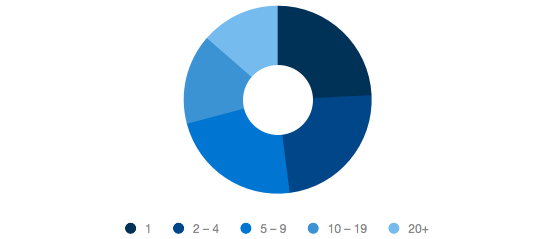
On average, 2.7 users are collaborating on one account. But the chart above shows that this figure isn’t significant at all. At the moment, about 24% of all users fight alone. Our biggest accounts count more than 50 users though – a really diverse customer base.
Monthly revenue / monthly expenses
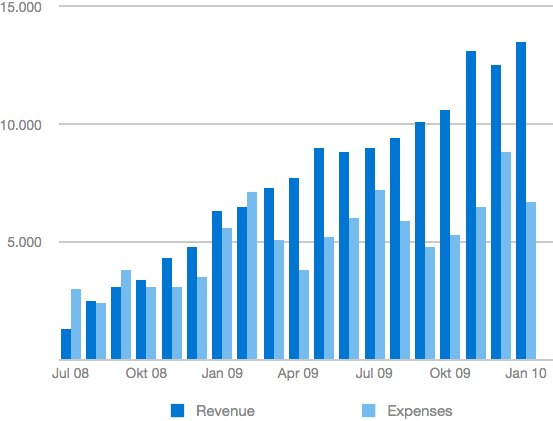
mite doesn’t grow exponentially. We’re a slow grower, and you know what? We’re happy with that. The trend is what matters. It’s positiv enough to take the next step: the duo behind mite is looking to 1-up the team.
Feedback, please?
No matter how cool we play: to get that naked in public cost quite an effort. Vague statements à la »it’s going pretty well, thanks« are passé, now. We know that. And we hope it’s worth it!
Therefore, we’d be double happy if you’d left a comment: Does this transparency help you? What figures came as a surprise, and what did you assume? Any lessons learned? And… how’s your SaaS start-up going?
Julia in Inside out
Got something to add?